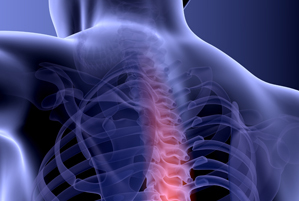
The healthy human spine consists of 33 bones, named vertebrae. The upper (cervical) includes 7, the mid (thoracic) includes 12 and the lower (lumbar) includes 5. Those vertebrae are traditionally considered to account for a total of 24 joints. Along with the sheer skeletal structure, flexible discs exist between the vertebrae acting as “shock absorbers” to provide ease of motion. The spine also functions as a conduit for nerve fibers that branch outward and encompass the rest of the body.
Simply put, the shape and function of the spine is a truly astonishing and complex structure. The spine is capable of sustaining a great degree of pressure and weight. While noted that the average, healthy, man should be able to support 1,000 -1,500 pounds, we don’t recommend that! So, let’s consider a more common weight: the 10-pound grocery bag.
Since most of us in the Rochester, New York area have to purchase (versus producing) our own food, we will most likely find ourselves at the grocery store or some type of market. A few items placed in a bag can easily become a 10-pound weight. So how does carrying that affect our bodies? Let’s take a look at what factors affect that!
How many bags are you holding?
Carrying a 15-pound weight from the store to your car should be fairly simple and easy for most healthy adults. Many reading this though may find themselves guilty of saying “Just one more bag is no big deal.” In most cases you’re probably right. But by the time you know (and admit) that the weight was a bit too much for you, the damage is already done. OUCH! Something hurts and it may not be going away, soon.
How close to your body? The closer to the center of your body (in this case, your spine), the easier it is to carry. As shown in the figure below, the greater the distance from your spine, the lesser your ability to safely carry a weight.
Weight vs. Motion
Frankly, bad bio-mechanics is traditionally what causes someone to see us at Rochester Family Chiropractic. By that, we mean moving your body in a manner that best promotes good health and avoids unnecessary, physical stress. We suggest you consider the health of your back and spine before approaching any type of physical action. The simple act of lifting those four grocery bags (a total of 40 lbs) and turning at the same time can add a considerable amount of stress on every joint that’s in use. And with 24 joints in the human spine, this is the spot most likely to be injured.
Planning how to lift a weight.
Addressing each opportunity to “lift and carry” can become second nature (and thereby “faster”) once you begin practicing “the plan”.
- Squaring up. Face the item to be lifted so your shoulders are parallel to the item being lifted.
- Reaching down. If you need to reach low, get there by bending with your knees instead of your back.
- Secure your grip. Ensure that the weight is solid and can be managed. A box that’s likely to collapse is a risk you don’t want! The interior items could drop out and break. They may fall and injure your feet. They may even cause to you to rapidly adjust to attempt catching it. This is often the case we hear about injured backs.
- Lift and THEN turn. Once the weight is up where you want it. Turn with your feet and legs vs twisting at the spine.
- Placing the weight. Performing the same steps in reverse is the surest means to maintain a healthy spine.
Last but not least, don’t wait.
We often hear from patients “I thought it would get better”. Trust us, it’s not. While minor muscle soreness will fade, joints that are slightly misaligned due to minor injuries can cause major issue. These minor misalignments will often cause your body to compensate slightly to deal with the pain. Months later you can find yourself wondering what happened and why you’re feeling so terrible. Call us and schedule an appointment. Adjustments performed by your favorite Rochester-based Chiropractor (Rush-Henrietta Family Chiropractic, of course) can be very efficient and help you feel your best.
Contact us with any questions at 585-321-3200.



